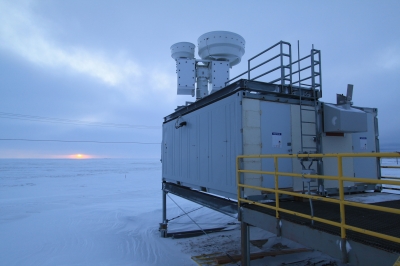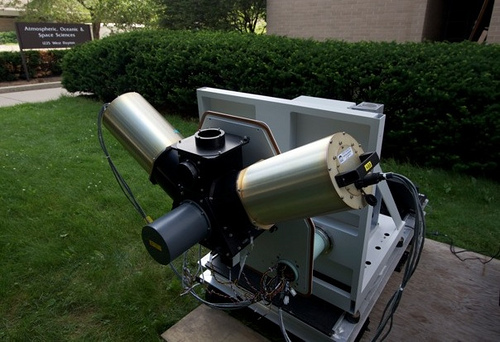Researchers link rising carbon dioxide levels from fossil fuels to an upward trend in radiative forcing at two locations

Scientists have for the first time observed an increase in carbon dioxide’s greenhouse effect at the Earth’s surface. The research, conducted using data and data products from the Atmospheric Radiation Measurement (ARM) Climate Research Facility, is reported Wednesday, February 25, in the advance online publication of the journal Nature.
The data were used by scientists from the U.S. Department of Energy’s (DOE) Lawrence Berkeley National Laboratory, who were able to measure atmospheric carbon dioxide’s increasing capacity to absorb thermal radiation emitted from the Earth’s surface over an 11-year period at ARM research sites in Oklahoma and Alaska. The researchers attributed this upward trend to rising carbon dioxide levels from fossil fuel emissions.
Study results agree with theoretical predictions of the greenhouse effect due to human activity, which had not been experimentally confirmed outside of a laboratory until now. The research, funded by the DOE Atmospheric System Research program, also provides further confirmation that the calculations used in today’s climate models are on track when it comes to representing the impact of carbon dioxide.
“We see, for the first time in the field, the amplification of the greenhouse effect because there’s more carbon dioxide in the atmosphere to absorb what the Earth emits in response to incoming solar radiation,” said Daniel Feldman, a scientist at Berkeley Lab and lead author of the Nature paper.
Incredibly Precise Instruments

Researchers used the Atmospheric Emitted Radiance Interferometer (AERI), a ground-based spectroscopic instrument designed at the University of Wisconsin-Madison, along with incredibly precise spectroscopic instruments operated by the DOE’s ARM Facility at the two research sites to observe and measure thermal infrared energy that travels down through the atmosphere to the Earth’s surface. These instruments detect the unique spectral signature of infrared energy from carbon dioxide.
“The measurement is the core of the study,” said Jim Mather, ARM Technical Director. “Observing this effect took advanced measurements over a long period of time, and there are very few places where this is possible. The complex data collected by ARM on a continuous basis is what allows this kind of work to be done.”
Proven Value
Jonathan Gero, ARM instrument mentor for the AERI at the University of Wisconsin, said, “This instrument has over and over again proven its remarkable value. It provides an incredible amount of detailed data about atmospheric components that are hard to get any other way.”
In addition, Tim Shippert, Pacific Northwest National Laboratory, and Eli Mlawer, Atmospheric and Environmental Research (AER), were integral in providing support to determine the fair-sky bias in the study’s results using data from the Broadband Heating Rate Profile Project (BBHRP). Berkeley Lab utilized the AER Line-by-Line Radiative Transfer Model calculations to analyze the data from ARM’s radiometers (i.e., the AERIs).
Scientists measured radiation in the form of infrared energy, controlling for other factors that would impact the measurements, such as weather. The result is two time-series from two very different locations and climates. Each series spans from 2000 to the end of 2010, and includes 3,300 measurements from Alaska and 8,300 measurements from Oklahoma obtained on a near-daily basis.
Similar Effects
Gero said the results for the increase in greenhouse effect were similar for the two locations—atmospheric carbon dioxide emitted an increasing amount of infrared energy.
This increase at the surface is almost ten percent of the trend from all sources of infrared energy in the Earth’s atmosphere. Applying analyses of data from the National Oceanic and Atmospheric Administration’s (NOAA’s) CarbonTracker system, scientists related this upswing in carbon dioxide to a sustained imbalance between incoming and outgoing energy—or radiative forcing—to fossil fuel emissions and fires. Their results agreed with theoretical predictions that greenhouse effects are due to human activity.
You can find the Nature article online now.
For more information, read the Berkeley Lab press release. For data like that used in the study, visit the ARM Data Archive.
# # #
The ARM Climate Research Facility is a national scientific user facility funded through the U.S. Department of Energy’s Office of Science. The ARM Facility is operated by nine Department of Energy national laboratories.

